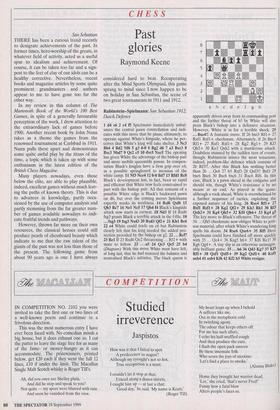CHESS
San Sebastian THERE has been a curious trend recently to denigrate achievements of the past. In former times, hero-worship of the greats, in whatever field of activity, acted as a useful spur to idealism and achievement. Of course, it can be taken too far and a sign- post to the feet of clay of our idols can be a healthy corrective. Nevertheless, recent books and magazine articles by some quite prominent grandmasters and authors appear to me to have gone too far the other way.
In my review in this column of The Mammoth Book of the World's 100 Best Games, in spite of a generally favourable perception of the work, I drew attention to the extraordinary lack of games before 1900. Another recent book by John Nunn takes as a theme the games from the renowned tournament at Carlsbad in 1911. Nunn pulls these apart and demonstrates some quite awful play by the titans of the time, a topic which is taken up with some enthusiasm in the latest edition of the British Chess Magazine.
Many players nowadays, even those below the elite, are able to play plausible, indeed, excellent games without much leav- ing the paths of known theory. This is due to advances in knowledge, partly occa- sioned by the use of computer analysis and partly stemming from the far greater num- ber of games available nowadays to indi- cate fruitful trends and pathways.
However, thrown far more on their own resources, the classical heroes could still produce pearls of chessboard beauty which indicate to me that the raw talent of the giants of the past was not less than those of the present. The following game from about 90 years ago is one I have always
Past glories
Raymond Keene
considered hard to beat. Recuperating after the Mind Sports Olympiad, this game sprang to mind since I now happen to be on holiday in San Sebastian, the scene of two great tournaments in 1911 and 1912.
Rubinstein—Spielmann: San Sebastian 1912; Dutch Defence 1 d4 e6 2 c4 f5 Spielmann immediately unbal- ances the central pawn constellation and indi- cates with this move that he plans, ultimately, to operate against White's kingside, where he per- ceives that White's king will take shelter. 3 Nc3 Bb4 4 Bd2 Nf6 5 g3 0-0 6 Bg2 d6 7 a3 Bxc3 8 Bxc3 Nbd7 9 Qc2 c5 10 dxc5 NxcS The opening has given White the advantage of the bishop pair and more mobile queenside pawns. In compen- sation Black's knights have a firm grip over e4, as a possible springboard to invasion of the white camp. 11 Nf3 Nce4 12 0-0 Bd7 13 Rfdl Rc8 Black's development has, in fact, been so rapid and efficient that White now feels constrained to part with the bishop pair. All that remains of a possible White edge is Black's backward pawn on d6, but over the coming moves Spielmann expertly masks its weakness. 14 Bxf6 Qxf6 15 Qb3 Rc7 16 Nel Nc5 17 Qb4 f4 Black's kingside attack now starts in earnest. 18 Nd3 If 18 Rxd6 fxg3 grants Black a terrible attack in the f-file. 18 ...fxg3 19 fxg3 Nxd3 20 Rxd3 Qf2+ 21 KU Bc6 22 e4 White could trade on c6 but Rubinstein clearly felt that his king needed the added pro- tection provided by the bishop on g2. 22 ... Rcf7 23 Rel If 23 Rxd6 Qe2 threatening ... Rfl+ with mate to follow. 23 ... a5 24 Qc3 Qc5 25 b4 (Diagram) With this move White must have felt, at long last, that he had restored the balance and neutralised Black's initiative. The black queen is apparently driven away from its commanding post and the further threat of b5 by White will also press Black's bishop into a defensive situation. However, White is in for a terrible shock. 25 ...Bxe4!! A fantastic move. If 26 bxc5 Rfl+ 27 Rxfl Rxfl+ checkmate. Alternately, if 26 Bxe4 Rfl + 27 Rxfl Rxf1+ 28 Kg2 Rgl + 29 Kf3 Qh5+ 30 Ke3 Qxh2 with a murderous attack. Doubtless stunned by the sudden turn of events, though, Rubinstein misses the most tenacious, indeed, problem-like defence which consists of 26 Rf3!!. After this Black has nothing better than 26 ...Qc6 27 b5 Rxf3 28 Qxf3!! thcf3 29 bxc6 Bxc6 30 Bxc6 bxc6 31 Rxe6 Rf6. In this case, Black is a pawn ahead in the endgame and should win, though White's resistance is by no means at an end. As played in the game, although a rook ahead, White is overwhelmed by a further sequence of tactics, exploiting the exposed nature of his king. 26 Rxe4 Rfl+ 27 Bxfl Rxfl+ 28 Kg2 Qf2+ 29 Kh3 Rhl 30 Rf3 Qxh2+ 31 Kg4 Qh5+ 32 Kf4 Qh6+ 33 Kg4 g5 The key move to Black's offensive. The threat of 34 ... Qh5 checkmate now obliges White to jetti- son material, after which White's wandering king spells his doom. 34 Rxe6 Qxe6+ 35 Rf5 Here Spielmann could have finished off more quickly with 35 Qe4+ 36 Kxg5 h6+ 37 Kf6 Rel! 38 Kg6 Qg4+. A tiny slip in an otherwise unimagin- ably brilliant game. 35 h6 36 Qd3 Kg7 37 Kf3 Rfl+ 38 Qxfl Qxf5+ 39 Kg2 Qxfl+ 40 Kxfl axb4 41 axb4 Kf6 42 Kf2 h5 White resigns


























































































 Previous page
Previous page